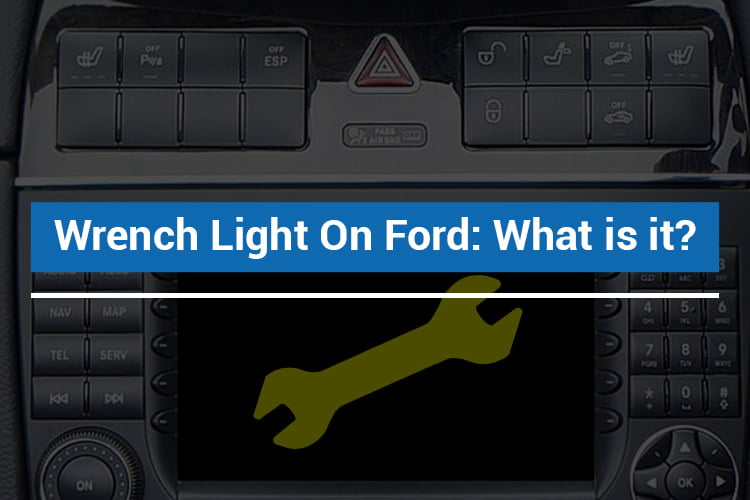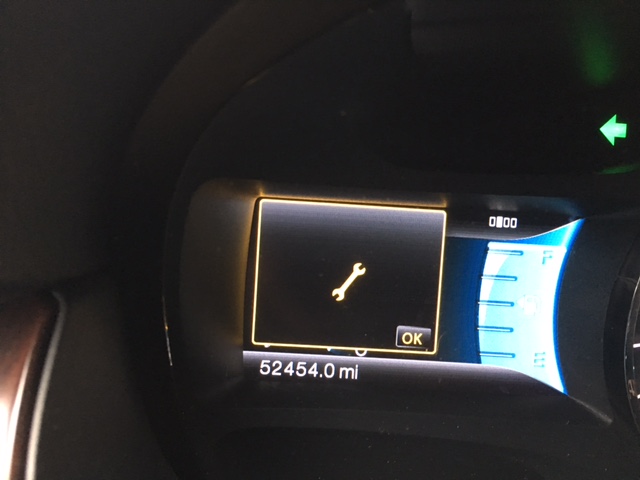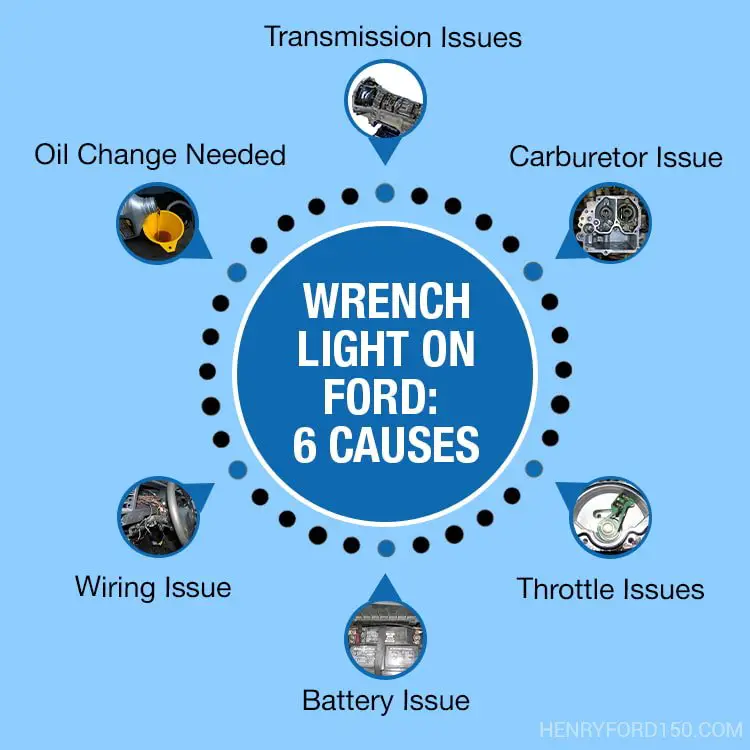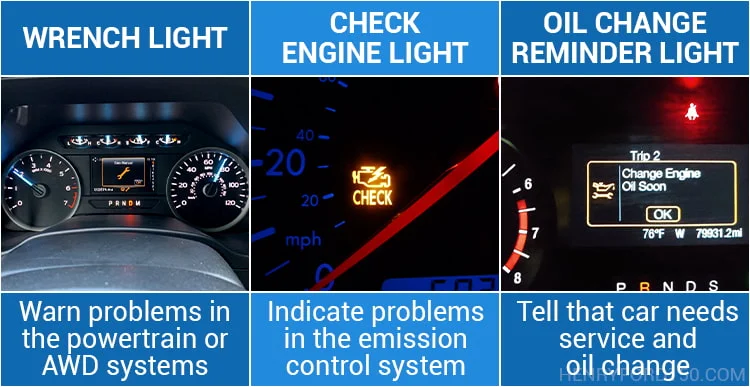Ford enthusiasts are generally familiar with all the fantastic safety features within the vehicle, but something that they miss out on is the wrench dash light. The confusing part is what it indicates.
For starters, the wrench light on Ford is trying to point out big problems within your powertrain and four-wheel-drive system. It warns you about any potential malfunction, which, if ignored, might lead to more significant problems.
If you, too, own a Ford truck and are clueless as to what the wrench symbol on the dashboard means, then you have landed on the right page. I will give you a thorough ride about the concept behind that warning light. The article will also guide you on how to handle the situation.

What Does The Wrench Light Mean?
The Ford wrench light is designed to warn drivers about any problem deep within the car. It is a built-in warning system developed by Ford manufacturers.
The wrench light blinks every time the system detects a powertrain malfunction or an issue with the four-wheel-drive system. It is designed with sensors to catch any problem within your engine and warn you of any malfunction.

The powertrain comprises vital parts of your vehicle, including the engine, transmission, and driveshaft. And there could be a list of faults in these parts causing the wrench dash light to lit up. A wiring problem, powertrain sensors malfunction, or maybe your car is signaling you to change the oil are only a few reasons that might bring the wrench light to life.
The wrench light triggers the fault codes encrypted in the system memory. To retrieve these codes, you need a Ford technician to scan and generate the error codes for you.
So, the simplest solution to turn off the wrench light is to drive your vehicle to the nearest car dealership slowly. The dealer will use the scanner to obtain the error codes. He will then resolve the underlying issues of your vehicle. However, if you would love to solve your car issues on your own, move to section IV in this article to learn a few tips.
Can You Drive With The Wrench Light On?
If you have no way of retrieving the computer-generated codes and are clueless about the problem, it is recommended not to drive the car with the wrench symbol blinking.
This is because driving the vehicle will further damage the powertrain causing you to spend a fortune on the repair. So, it is best to slow down the car and try to diagnose the issue. If you have the tool to generate the computer codes for the fault, you can identify the problem independently.
However, if this sounds too technical to you, then tow the car to an auto car dealership. He will better comprehend the problem and will fix your Ford vehicle in less than an hour.
If you continue to drive your Ford truck with the wrench light illuminated, the speed of your truck will slow down. You won’t be able to shift gears or increase the speed of your Ford truck.
If the problem is serious and you still force your truck to move forward, you will damage the engine of the Ford. It will lead to extensive repairs.
Wrench Light On Ford: What Are The Causes?
Various reasons cause the yellow wrench light to pop up on the dashboard of your screen. Either check the wiring manually or run an OBD scan to decipher the error codes. Having an OBD scanner in your vehicle will help you find the fault within the system with precision.
So, let’s see what problems your Ford might be facing, and we will also discuss the solutions alongside.

Transmission Issues
Transmission issues are often the biggest cause that triggers the wrench car light. The engine will refuse to start, slipping gears, burning more fuel, leaking fuel, and noises coming out from the engine are common indicators causing failure within the transmission system.
In this situation, the Engine Control Module (ECM) or Powertrain Control Module (PCM) are the main culprits! PCM is located at the heart of your Ford’s engine. It receives data from all engine sensors and is responsible for the efficient movement of your vehicle. PCM ensures the optimal performance of your engine while also consuming less fuel in the process.
There could be minor issues within your transmission, such as a loose or broken wire. The best way to find out the real problem is to take your vehicle to a mechanic. If the problem is severe, it might take a few days to repair the vehicle.
Carburetor Issue
A damaged carburetor is another vital part of a Ford truck. A problem with the carburetor will cause the engine to jolt. It will also cause the engine to overheat, activating the wrench symbol to blink.
Sometimes a little cleaning in the carburetor may start your engine. However, if the problem remains persistent, it is best to take your vehicle to the nearest service center. They have the tools and expertise to rebuild the carburetor. If the carburetor is beyond repair, it will need to be replaced.
Throttle Issues
A problem with the throttle also disturbs the wrench light. The light flickers every time you start the vehicle. At times the wrench light in the car also illuminates even when the vehicle is parked in the garage.
The Electronic Throttle Body (ETB) might have become dirty due to carbon build-up. The dirt hinders the movement of the throttle plate, which will not align with the data within the system.
Before you head to a mechanic, try cleaning the debris from the throttle. Use a suitable cleaner to clean the dirt from the throttle.
Battery Issue
A messed-up or low battery also causes the wrench light to come up. A drained-out battery also adds up to the reasons causing the warning light to blink continuously.
If you think it’s the battery, the easiest way to confirm your theory is to try a spare battery. Batteries with low voltage and even dead batteries can be changed in less than an hour.
Wiring Issue
At times a loose or unfixed wire can trigger Ford’s wrench light. The wire is connected to the vehicle’s computer system, which forces it to activate the fault codes. And the tool light on the car begins flashing. The simplest solution is to look for the loose wires. Connect them to the circuit board, and you are good to go.
Your Vehicle Needs An Oil Change
Ford vehicles need an oil change every three months. If it’s been a long time since your car received a fuel change, then consider the yellow wrench light a reminder to do it as soon as possible.
Tricks: 6 Steps To Do When The Wrench Light on Ford Comes On
If the wrench light comes upright in the middle of a deserted road, here are a few tricks you can use to settle the wrench light on your own. But first things first,
● Turn on the emergency flasher lights.
● Pull over to the side of the road safely.
And then, carefully check out these steps if you can successfully resolve the wrench light issue.

Step 1: Turn OFF the truck for a few minutes and turn it ON
Turn off your truck for a few minutes and let the engine cool down. Once the powertrain cools, restart your engine. There are high chances the yellow light will stop flashing.
Step 2: Disconnect and reconnect the battery’s negative terminal
Remove the negative terminal of the battery for 10-15 minutes. Then reconnect the terminal. It will reset the control modules by draining the power.
Step 3: Use a code scanner to detect the problem
A code scanner can help you find the problem without any hassle. An OBD ll Scan tool will allow you to see the codes. You can easily tackle the issue and get your Ford in the first gear as soon as the code comes up.
If no code comes up, don’t take it as a false alarm and visit the technician as quickly as possible.
However, if you do not have an OBD scanner right now, a Ford service center or any other automobile shop can lend you one at a fair price. If luck is on your side, you might be able to get codes without spending any money at all!
Step 4: Check Powertrain Control Module and replace (if necessary)
Often checking and replacing the powertrain module can turn off the wrench light. PCM is the heart of your engine. It monitors the performance, speed, and all other functions of your vehicle. Several things in the PCM can cause the wrench light to flash, including:
● The wires may not be adequately insulated and are not broken at any point.
● Check the connectors for any sign of damage. Look for bent pins or broken connector blades.
● Check for any sign of water damage. If the water manages to enter the PCM may cause a short circuit or even cause corrosion over time. In that case, you need to take your Ford vehicle straight to a certified car dealer. He will replace the circuit board without causing any further damage to your vehicle.
But if it leads to replacing the PCM, things might get tricky. The PCM might be located under or behind other engine components depending on the make and model. You may find the PCM in the instrument panel, under the console, or it may be situated under the car’s seat.
If you do not have the technical expertise to carry out the replacement process, visit a Ford car dealership in town.
Step 5: Check Electronic Throttle Body (ETB), clean and replace (if necessary)
Check the ETB and Throttle position center. Either the ETB is open, or there is dirt in the sensor. Firstly, locate the ETB box and pull off the air intake snorkel. Remove one bolt and clean the dirt from the entire area. Look for the MAF sensor that would be connected to the airbox housing. Remove the airbox, and you will be able to see the ETB.
Step 6: Replace transmission fluid
Drain the old fluid, clean the pans, and pour in new fresh oil and fluid. This will pour a new life into your vehicle and might also turn off the wrench light. But make sure to use a transmission fluid mentioned in the user manual.
Estimated Repair Cost To Resolve The Wrench Light On Ford
The estimated repair cost depends upon the damage your Ford vehicle underwent. The error codes will identify the problem, and the cost will be based on the issue that comes forth.
Read more: Ford F150 PCM Failure Symptoms
Frequently Asked Questions
Q1. Is Powertrain Malfunction A Serious Problem?
Answer:
Yes. It is a serious problem in your engine that slows down your speed, disturbs your vehicle’s performance, and will also cause extensive damage to the entire Ford engine.
Q2. Wrench Light vs. Check Engine Light vs. Oil Change Reminder Light: What Are The Differences?
Answer:
These three lights may flicker simultaneously. They both indicate that there is an issue with your car. Besides this single similarity, there are a lot of differences between the three.
Wrench Light: A built-in component of Ford’s warning system. It comes on to warn drivers about problems in the powertrain or all-wheel-drive systems.
CEL: A component of the On-Board Diagnostics (OBD) program, available in all cars. It illuminates to typically indicate problems in the emission control system.
Oil change light: More of a reminder light. It often comes up with the wrench light indicating that the car needs service and the oil need to be changed.

Q3. My Ford entered Fail-Safe Mode shortly after the wrench light illuminated. What happened?
Answer:
No worries. That’s how Ford protects your engine from extensive damage and costly repairs.
When detecting an issue with the power train, the system displays a warning signal on your car dashboard and then possibly activates the “Limp Mode”, also known as the “Fail-Safe Mode”. In this situation, the vehicle will face a sudden loss of power. The Limp Mode will keep your car/truck move at a maximum speed of just about 5-10 MPH. By cutting down your vehicle’s power, the system aims to prevent any further damage to the powertrain components. This is an intelligent way of protecting your car from extensive repairs.
Q4. How do you know if your powertrain is bad?
Answer:
The signs that warn you about a bad powertrain are:
- You’re unable to connect the OBD2 scanner to your car.
- The check engine light turns on
- Your Ford doesn’t ignite or starts roughly
- You notice a reduced gas mileage
- Your vehicle failed the emissions testing
- The engine delays or stops running
- You find it difficult or abnormal to shift into gears
- You get PCM (powertrain control module)-related codes such as P0606, P0603, P0113, U0100
- Engine misfires or backfires
I’ve conducted thorough research about Ford F-150 PCM failure symptoms. You can read it here: Ford F150 PCM Failure Symptoms – 9 Most Common Symptoms Explained.
Wrapping Up
People who own Ford often face the Ford wrench light issue. Instead of ignoring it, it is best to catch the warning signal your vehicle is throwing at you.
At times, there could be minor problems, such as a low battery or loose wires. But some major problems in the transmission or throttle can also cause the sensors to issue signals. If you are not a technical person, it is best to take your vehicle to the mechanic ASAP. Once repaired, your Ford is ready to hit the road again!